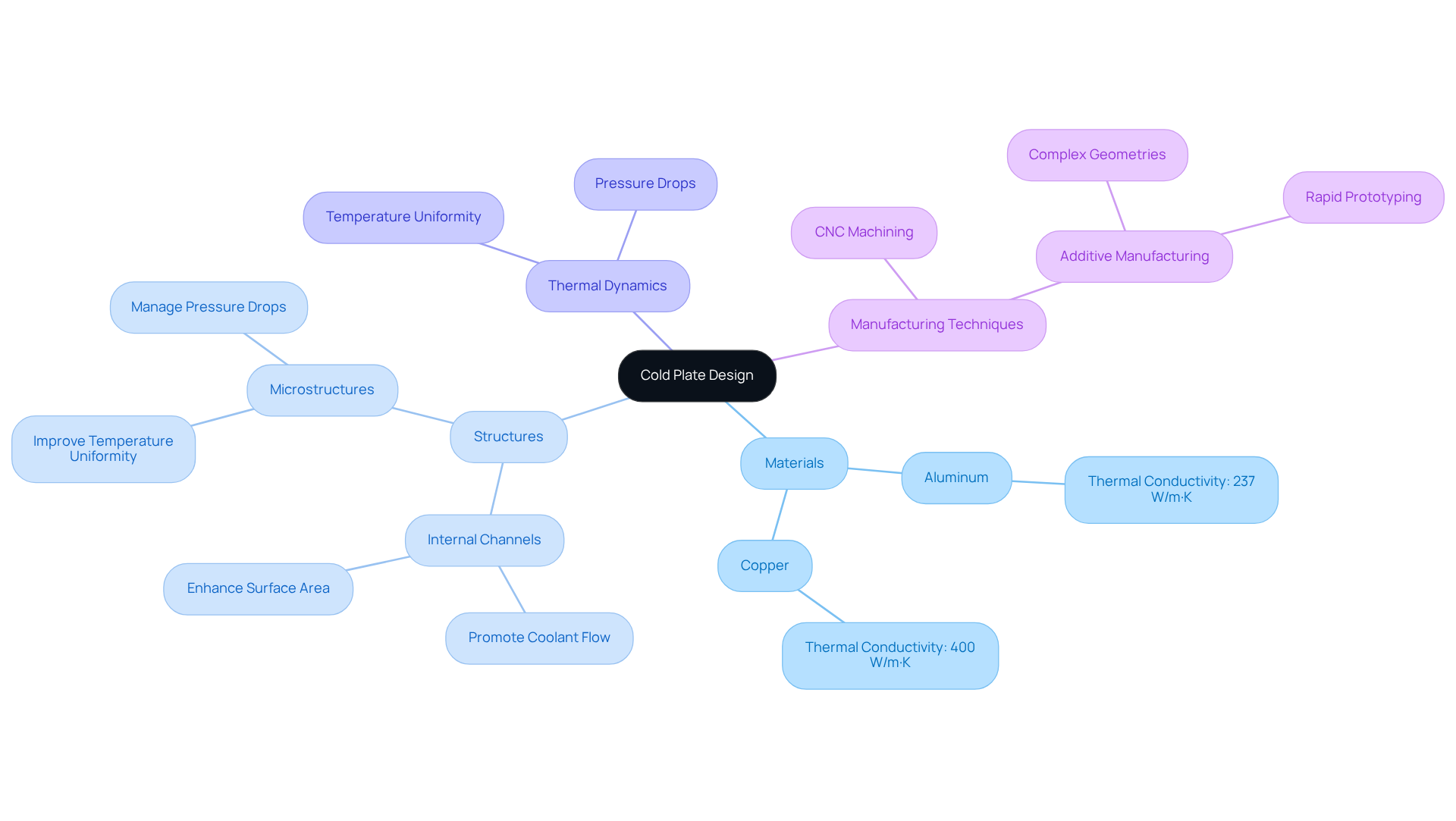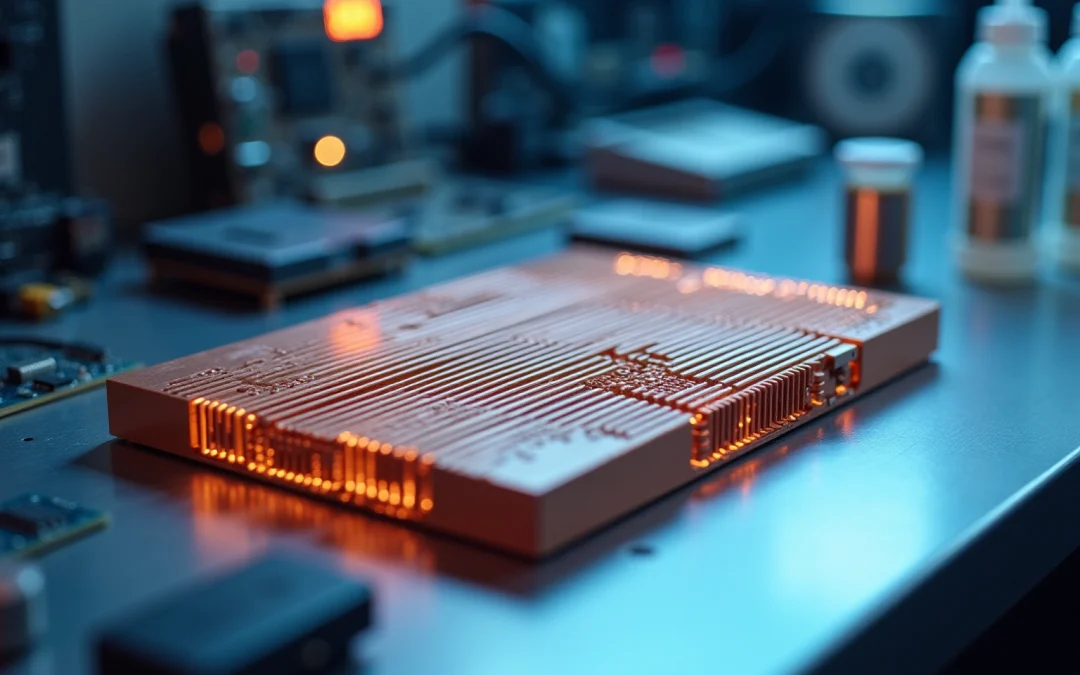Overview
A cold plate serves as an essential heat management device, meticulously engineered to extract heat from electronic components and effectively transfer it to a liquid coolant. This process is vital for maintaining optimal operating temperatures in sensitive systems. Constructed from materials such as aluminum and copper, cold plates feature advanced design elements, including internal channels that facilitate efficient coolant flow. Their critical role spans various applications, particularly in data centers and aerospace, underscoring their importance in preventing overheating and significantly enhancing system reliability.
Introduction
In an era where electronic devices are not only becoming increasingly powerful but also more compact, the effective management of heat has never been more crucial. Cold plates, which are essential components in thermal management, are specifically designed to absorb and dissipate heat from sensitive electronics. This ensures optimal performance and longevity.
However, as technology continues to evolve and power densities rise, one must consider how these chilled surfaces adapt to meet the growing demands of industries such as data centers and aerospace. A thorough understanding of the intricacies of cold plate design and their diverse applications reveals not only their significance but also the innovations propelling their development forward.
Define Cold Plate: Core Concepts and Functionality
? It is a chilled surface that serves as a critical , expertly designed to extract heat from electronic components by transferring it to a liquid coolant. Constructed from materials with high thermal conductivity, such as aluminum or copper, these cold surfaces facilitate through direct contact with heat-generating elements. The coolant navigates through intricately designed channels within the surface, absorbing heat and transporting it away to uphold optimal operating temperatures in sensitive electronic systems.
This technology is indispensable in scenarios where overheating may result in performance degradation or failure, particularly in high-power electronics, data centers, and aerospace systems. Chilled surfaces can achieve significant temperature reductions, ensuring the reliability and longevity of vital components. Their integration into (HPC) clusters and electric vehicles underscores their importance in modern heat control solutions, where effective heat dissipation is paramount.
, including solenoid pumps and rotary boost pumps, further enhance the efficiency of these systems. Solenoid pumps can operate at pressures up to 16 Bar, providing precise control for , while rotary boost pumps equipped with DC brushless motors guarantee low noise operation and EMI suppression.
What is a cold plate can be categorized alongside other cold surfaces into types such as:
- Tubed
- Brazed
- Friction stir welded
Each presenting unique advantages tailored to various applications.
Trace the Evolution of Cold Plates: Historical Context and Advancements
The development of spans several decades, originating in aerospace and industrial sectors where was paramount. Initially, designs featured simple metal sheets that effectively transferred heat away from sensitive components. However, as technology progressed, advancements in materials science and manufacturing techniques led to the creation of more intricate thermal devices, including microchannel designs that significantly enhance heat transfer efficiency.
The escalating power density of electronic devices, coupled with the demand for , has further propelled innovations in . Today, chilled surfaces are indispensable in contemporary applications, such as data centers and electric vehicles, where is critical for optimal performance and reliability.
Noteworthy case studies, such as Aavid’s introduction of aluminum nitride and Lytron’s modular cooling system, illustrate how these innovations have transformed industries, underscoring the vital role heat exchangers play in .
The chilled surface market is projected to reach USD 534 million by 2032, reflecting the growing necessity for effective refrigeration solutions. Furthermore, is expected to expand from $5 billion in 2025 to over $9 billion by 2033, driven by the increasing adoption of and the proliferation of data centers.
Examine Cold Plate Design: Materials, Structures, and Thermal Dynamics
Chilled surfaces are predominantly constructed from materials exhibiting high heat conductivity, notably aluminum and copper, which are essential for . Aluminum typically has a conductivity of approximately 237 W/m·K, while copper surpasses this with around 400 W/m·K, establishing copper as the preferred choice for applications requiring superior .
In discussing what is , it is noted that its design frequently integrates internal channels or microstructures that promote , thereby maximizing the surface area in contact with the heat source and enhancing . Research indicates that increasing the number of channels can significantly improve ; however, this may also result in higher pressure drops, necessitating meticulous design considerations.
, such as additive manufacturing and CNC machining, facilitate the creation of complex geometries that optimize heat efficiency. These innovations are particularly beneficial in high-heat applications within the electronics and aerospace sectors, where understanding is crucial for effective , maintaining operational efficiency and safety.

Explore Applications of Cold Plates: From Data Centers to Aerospace
play a pivotal role in various applications, particularly in sectors that demand . In data centers, they are vital for , where nearly 50% of the energy consumed by non-IT equipment is attributable to cooling systems, which represent approximately 38% of total energy usage. This underscores the critical function of chilled surfaces in ensuring optimal performance and reliability of computing systems.
The share of global electricity consumption by data centers increased from 0.5% in 2000 to 2% in 2022, further emphasizing the growing importance of like chilled surfaces. In the aerospace industry, chillers manage the , where precise temperature control is crucial for mission success. For instance, chilled surfaces are employed in military applications to guarantee the operational readiness of electronic components under extreme conditions.
Moreover, in electric vehicles, dissipate heat from batteries and power electronics, enhancing overall system efficiency and safety. The rapid expansion of the , projected to surge from USD 1.43 billion in 2022 to USD 7.26 billion by 2030, with a CAGR of 21.4%, highlights the increasing reliance on for effective temperature regulation. Their capacity to provide localized cooling positions them as a preferred solution in high-performance applications, reinforcing their significance in modern technology.
As noted by Gagner-Toomey Associates, understanding what is is essential for transferring energy from thermal sources to cooling systems, thereby ensuring the longevity and reliability of critical components.
Conclusion
Cold plates are essential components in thermal management, expertly engineered to extract heat from electronic systems with remarkable efficiency. Utilizing materials with high thermal conductivity and advanced cooling technologies, these chilled surfaces are pivotal in maintaining optimal operating temperatures, thereby ensuring the reliability and longevity of sensitive electronic components across diverse industries.
This article has explored key insights into the design, evolution, and applications of cold plates. From their fundamental construction using materials such as aluminum and copper to the sophisticated manufacturing techniques that enhance their efficiency, the significance of cold plates in high-performance computing, data centers, and aerospace has been clearly highlighted. The discussion surrounding their historical context and the projected growth of the cold plate market further emphasizes their indispensable role in modern technology.
As electronic devices continue to evolve and power densities escalate, the demand for effective thermal management solutions, like cold plates, becomes increasingly critical. Industries must prioritize understanding and implementing these technologies to ensure optimal performance and safety. By embracing innovations in cold plate design and application, stakeholders can significantly enhance the efficiency and reliability of their systems, paving the way for a more sustainable and technologically advanced future.
Frequently Asked Questions
What is a cold plate?
A cold plate is a chilled surface designed to extract heat from electronic components by transferring it to a liquid coolant. It is constructed from materials with high thermal conductivity, such as aluminum or copper, to facilitate efficient heat transfer.
How does a cold plate work?
A cold plate works by having its surface come into direct contact with heat-generating elements. The coolant flows through channels within the plate, absorbing heat and transporting it away to maintain optimal operating temperatures in electronic systems.
In what applications are cold plates used?
Cold plates are used in high-power electronics, data centers, aerospace systems, high-performance computing (HPC) clusters, and electric vehicles, where overheating can lead to performance degradation or failure.
What are the benefits of using a cold plate?
Cold plates provide significant temperature reductions, ensuring the reliability and longevity of electronic components by effectively dissipating heat.
What advanced pump technologies enhance cold plate efficiency?
Advanced pump technologies such as solenoid pumps, which can operate at pressures up to 16 Bar for precise coolant circulation, and rotary boost pumps with DC brushless motors for low noise operation and EMI suppression enhance cold plate efficiency.
What types of cold plates are there?
Cold plates can be categorized into types such as tubed, brazed, and friction stir welded, each offering unique advantages tailored to different applications.

